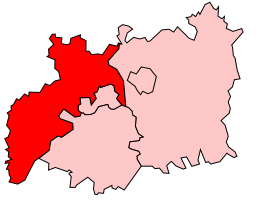Top Qs
Timeline
Chat
Perspective
West Gloucestershire (UK Parliament constituency)
Parliamentary constituency in the United Kingdom, 1950–1997 From Wikipedia, the free encyclopedia
Remove ads
West Gloucestershire was a parliamentary constituency in Gloucestershire, represented in the House of Commons of the Parliament of the United Kingdom.
It was first created by the Great Reform Act for the 1832 general election as a 2-seat constituency (i.e. electing two Members of Parliament). It was abolished for the 1885 general election.
Its namesake, a seat of about half the physical size of the above, took up a north-west side of the Severn estuary similar to the Forest of Dean, and came into being for the 1950 general election. It was abolished for the 1997 general election.
Remove ads
History
The 1950 to 1997 single-member constituency was held by the Labour Party from its creation in 1950 until 1979 and then held by the Conservative Party until its abolition.
Boundaries
Summarize
Perspective
1832 to 1885
1832–1885: The Hundreds of Berkeley, Thornbury, Langley and Swineshead, Grumbald's Ash, Pucklechurch, Lancaster Duchy, Botloe, St Briavel's, Westbury, and Bledisloe, and the parts of the Hundreds of Henbury and Barton Regis that are not included in the limits of the City of Bristol.[2]
The place of election was the small town of Dursley. This was where the hustings were put up and electors voted (by spoken declaration in public, before the secret ballot was introduced in 1872).
The qualification to vote in county elections, in the period, was to be a forty-shilling freeholder.
The county's five parliamentary boroughs were all in East Gloucestershire. Qualified freeholders from those boroughs could vote in the eastern county division. Bristol was a "county of itself", so its freeholders qualified to vote in the borough, not in a county division.
There were no electors qualified to vote in the western division, because they were freehold owners of land in a parliamentary borough.
1950 to 1997
1950–1983: The Rural Districts of East Dean, Lydney, Newent, and West Dean, and part of the Rural District of Gloucester.
1983–1997: The District of Forest of Dean, and the Borough of Tewkesbury wards of Brockworth Glebe, Brockworth Moorfield, Brockworth Westfield, Churchdown Brookfield, Churchdown Parton, Churchdown Pirton, De Winton, Haw Bridge, Highnam, Horsbere, and Innsworth.
The constituency in this period was a smaller part of the county of Gloucestershire than its nineteenth century namesake. It was centred on the Forest of Dean, and indeed the majority of the constituency at abolition formed the new Forest of Dean constituency. About a fifth of the constituency moved to Tewkesbury, with 735 constituents moving to Gloucester.[3]
Remove ads
Members of Parliament
MPs 1832–1885
MPs 1950–1997
Election results
Election in the 1990s
Elections in the 1980s
Elections in the 1970s
Elections in the 1960s
Elections in the 1950s
Elections in the 1880s
- Caused by Kingscote's appointment as Commissioner of Woods, Forests and Land Revenues.
Elections in the 1870s
Elections in the 1860s
- Caused by Rolt's appointment as a judge of the Court of Appeal in Chancery
- Caused by Rolt's appointment as Attorney General for England and Wales.
Elections in the 1850s
- Appointment of Kingscote as a Groom in Waiting to Her Majesty Queen Victoria
Elections in the 1840s
Elections in the 1830s
- Succession of Worcester to the peerage as 7th Duke of Beaufort
Remove ads
See also
Notes and references
Sources
Wikiwand - on
Seamless Wikipedia browsing. On steroids.
Remove ads


